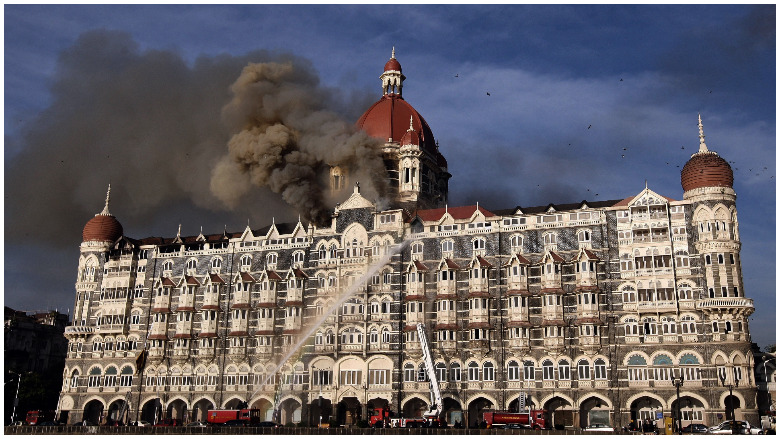
The movie Hotel Mumbai chronicles with gripping realism the 2008 terror attacks that trapped hundreds of guests and staff in a luxury hotel in India as terrorists stalked the halls.
The film doesn’t really have one hero, but many: The staff, especially, functions as a collective protagonist in a sense. In a hotel where “the guest is God,” the working class heroes stay behind to protect those they are charged to serve, willingly going down with the ship, so to speak. (Warning: There are some spoilers for the movie in this article.)
Some of the privileged guests also rise to their own best selves in the film, including the Russian former special forces soldier who starts out as an uncouth and lewd jerk and morphs into a selfless and courageous figure who spits in a terrorist’s face.
It all begs to question: How much of the story is real? What’s the true story behind Hotel Mumbai? First of all, the correct name of the hotel is Taj Mahal Palace Mumbai. It’s a five-star hotel, and, yes, it still exists, and you can book rooms there. You can see photos from the real siege throughout this article.
Here’s what you need to know:
The Pakistani Terrorists Slaughtered at Least 170 People in Mumbai
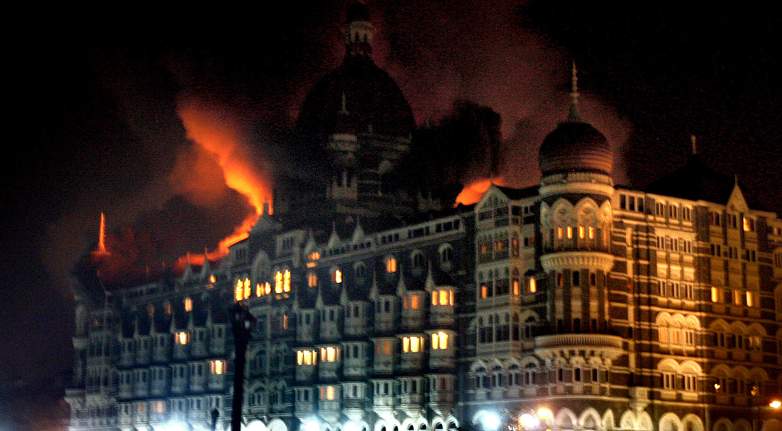
A fire breaks out of the dome of the Taj hotel in Mumbai on November 26, 2008. More than 80 people were killed in a series of attacks in the Indian city of Mumbai, with two five-star hotels among the targets of gunmen armed with powerful assault rifles and grenades.
The terror attacks were real, and they were as brutal as those shown on film. A Pakistani terror group launched the series of coordinated attacks throughout Mumbai, with some centered on the Taj. A RAND Corporation report on the attacks says 171 people died in them and calls them India’s 9/11. Another luxury hotel was also attacked.
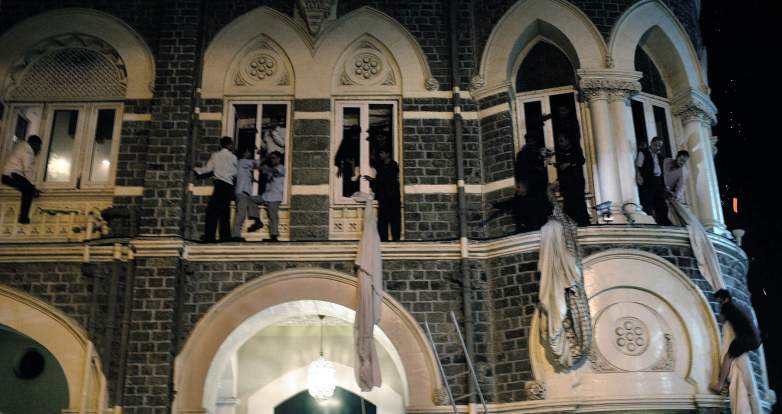
Employees and guests use curtains to escape the Taj Mahal hotel, site of one of the shootouts with terrorists.
According to CNN, a group of 10 terrorists attacked Mumbai from the group Lashkar-e-Tayyiba. As the movie shows, one of the terrorists was taken into custody. In real life, his name was Mohammed Ajmal Kasab, and he was executed in 2012, CNN reports. “Pakistan-based terrorists see India as part of the ‘Crusader-Zionist-Hindu’ alliance, and therefore the enemy of Islam,” the RAND Corporation report explained.
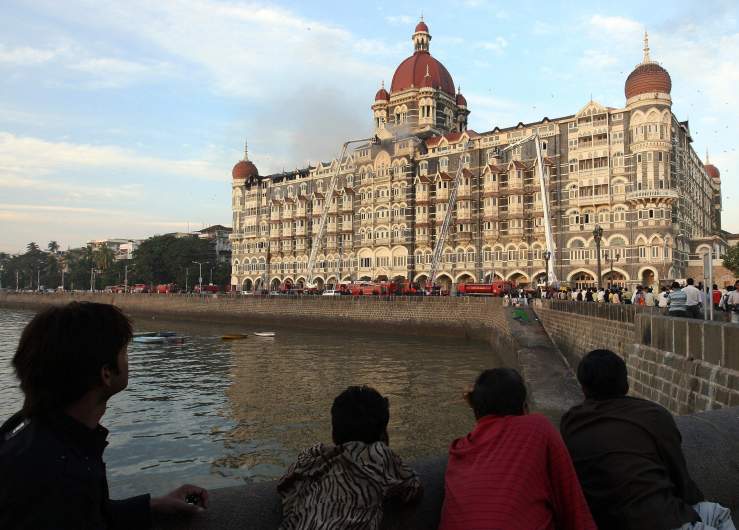
Indian bystanders look on as firemen attempt to put ot a fire at The Taj Mahal Hotel in Mumbai on November 27, 2008.
It’s also true that, as the movie shows, the terrorists took a police vehicle after slaughtering police officials and started their attack at the train station, where they murdered 58 people, according to CNN. They also struck a cafe, another hotel, and a Jewish community center. At the Taj, where 450 people were staying, 31 people died.
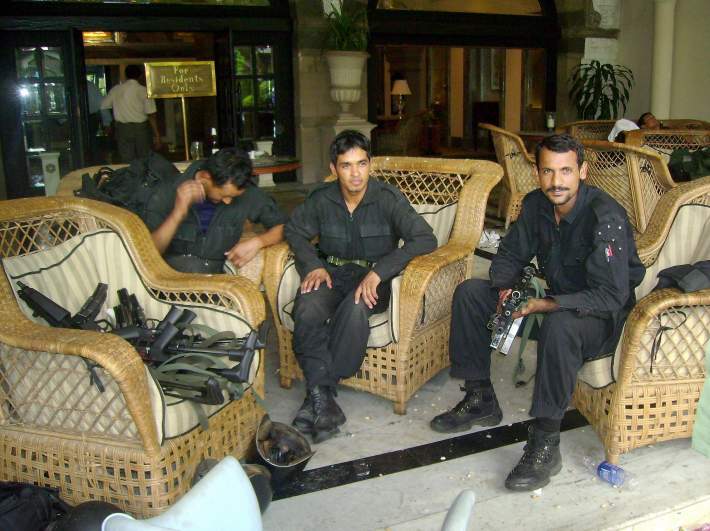
GettyIndian commandos rest in the lobby following a military operation at the Taj Mahal hotel in Mumbai on November 29, 2008.
It’s also true that the terrorists did not act alone. The alleged mastermind of the attacks was a terror group leader named Zaki-ur Rehman Lakhvi, Times of India reports. He was jailed and then released on bail, but he was also said to be spending his incarceration time in relative luxury. What the movie doesn’t show: In real life, a Pakistani-American named David Headly was sentenced to 35 years for his role in planning the attacks. He conducted reconnaissance in Mumbai for the terror attacks. The terror attacks soured relations between Pakistan and India.
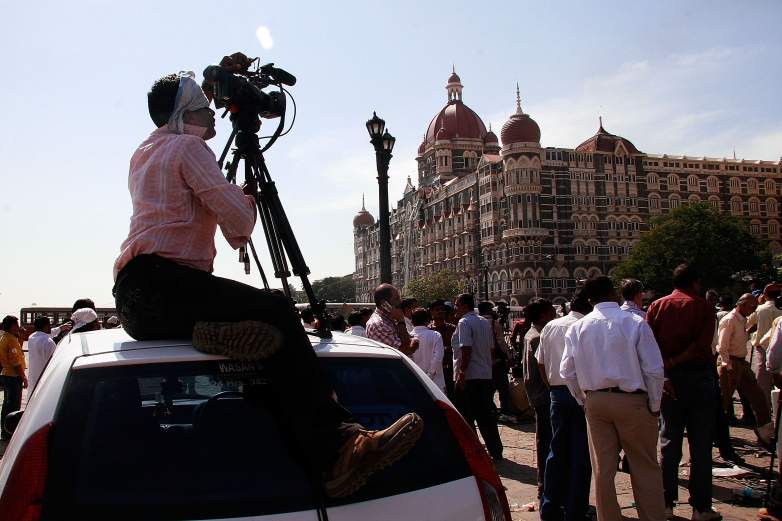
Members of the media report outside the Taj Mahal Palace & Tower Hotel November 27, 2008 in Mumbai, India.
According to NBC News, some of the terrorists’ dialogue was reconstructed in the movie from court transcripts in the case of the surviving gunman and from satellite phone conversations among the terrorists.

GettyA view from the Taj Mahal Hotel poolside restaurant is seen following a military operation at the hotel in Mumbai on November 29, 2008.
The hotel siege lasted 60 hours, according to BBC. In real life, the terrorists had carefully scoped out the Taj hotel before staging their attack. “The terrorists knew their way through hidden doors and back hallways of the hotel,” RAND’s report says. The terrorists arrived in Mumbai by sea.
“Multiple teams attacked several locations at once—combining armed assaults, carjackings, drive-by shootings, prefabricated IEDs, targeted killings (policemen and selected foreigners), building takeovers, and barricade and hostage situations,” according to RAND. In real life, the report says, the terrorists were urged on in real time by their Pakistani handlers who exhorted “them to kill, reminding them that the prestige of Islam was at stake, and giving them tactical advice that, in part, was gleaned from watching live coverage of the event on television.”
It’s also true that the special forces took hours to respond because their elite squadron was based in Delhi.
Some Characters Depicted in the Movie Aren’t Real

Indian woman Saroja Rao Bhanja, mother of forty-eight year-old Vijaya Rao Bhanja, an executive chef at the Taj Mahal Hotel in Mumbai who was killed by terrorists in the early hours of November 27, displays a photograph of her son at her residence in Hyderabad on November 28, 2008.
Here’s a partial list of some of the real victims of the Mumbai terror attacks. This article contains a list of the foreigners killed during the attacks, some evidence photos, and transcripts of the actual calls among the terrorists.
Arjun, the Sikh waiter played by Dev Patel, is one of the movie’s most humanistic characters. However, he isn’t real. Director Anthony Maras confirmed as much in an interview with Time Magazine, saying Arjun is based on a compilation of two real people, a waiter and “an unarmed security guard who was able to help lead a pair of police officers to the hotel’s CCTV room.”
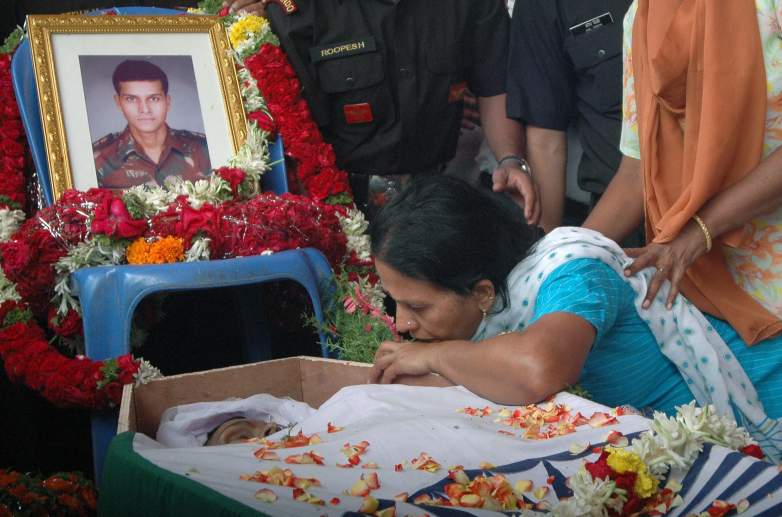
The mother of Indian National Security Group (NSG) commando Sandeep Unnikrishna gestures as she sits beside his coffin during a funeral ceremony in Bangalore on November 29, 2008.
Maras told Refinery29 that the real-life waiter “thought very quickly and had great initiative to turn all the lights off and get people ducking under the tables and was in frequent communication with (the head chef) to try and see how it was that they were going to protect these guests. And he did manage to ferry a whole lot of them to safety.”
Maras told the site that the characters were somewhat fictionalized in part to protect the privacy of the real people.
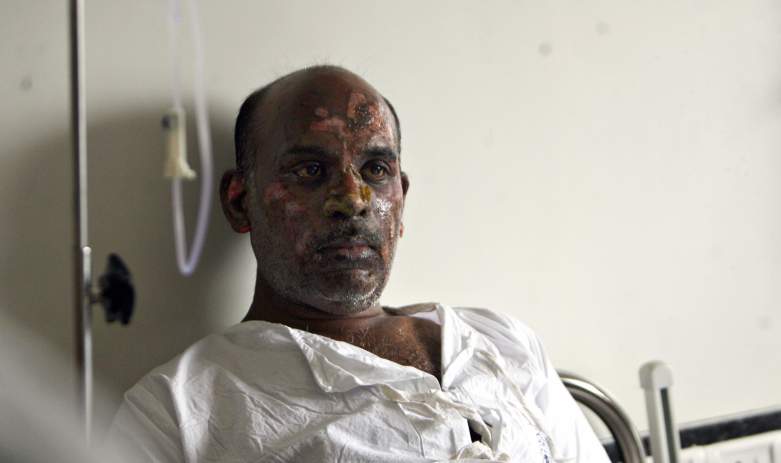
Indian police officer Deepak Dhole recovers at a hospital in Mumbai on November 30, 2008. Dhole was injured during the militant attack at the Taj Mahal Hotel in Mumbai.
Three of the other most prominent characters in the movie – the well-off married couple and the uncouth Russian businessman – are also not real. Zahra is played by Nazanin Boniadi, David by Armie Hammer, and Vasili by Jason Isaacs.
As with Arjun, Maras says that Zahra and David were based on two different couples, including one that really was taken hostage. Similarly, Isaacs is based on two people, Maras told Time.
The filmmakers interviewed 40 survivors before making the movie.
The Head Chef Really Did Save Lives at the Hotel

In this picture taken on October 30, 2018 Indian chef Hemant Oberoi, who helped rescue dozens of people during the 2008 Mumbai attacks, poses outside the Taj Palace Hotel in Mumbai.
One of the most interesting characters in Hotel Mumbai is the head chef, who is shown as an authoritarian stickler for details but later takes charge during the attacks and spirits dozens of people to safety in a barricaded room inside the Chambers Club.
Chef Hemant Oberoi is a real person. During the attacks, the well-known Indian chef stayed behind to help hide guests instead of trying to escape the hotel, according to People Magazine, which quotes him as saying, “That’s what we learned all our lives, that the guest is God and God has come to your house and the guest has come to your house.”
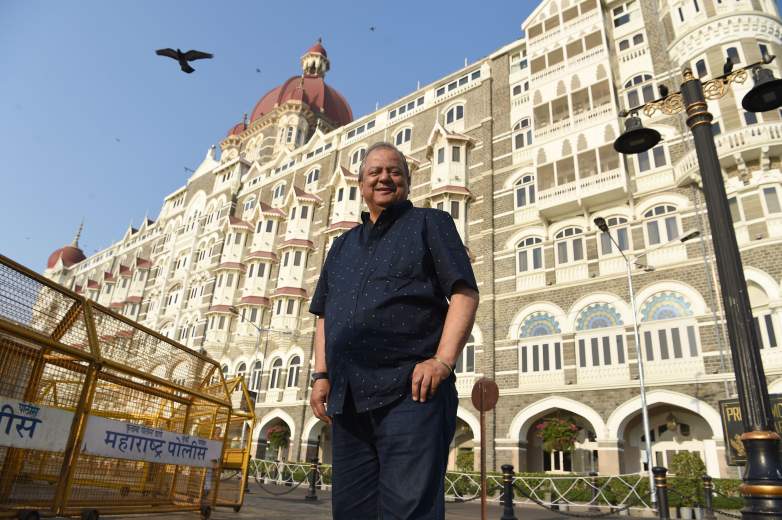
In this picture taken on October 30, 2018 Indian chef Hemant Oberoi, who helped rescue dozens of people during the 2008 Mumbai attacks, poses outside the Taj Palace Hotel in Mumbai.
Seven chefs lost their lives in the siege. According to People, Oberoi restored the Taj’s restaurants after the attacks, but then left to start his own series of restaurants throughout the world.
In real life, Oberoi and his team saved about 150 people.
There Were Many Real-Life Harrowing Stories
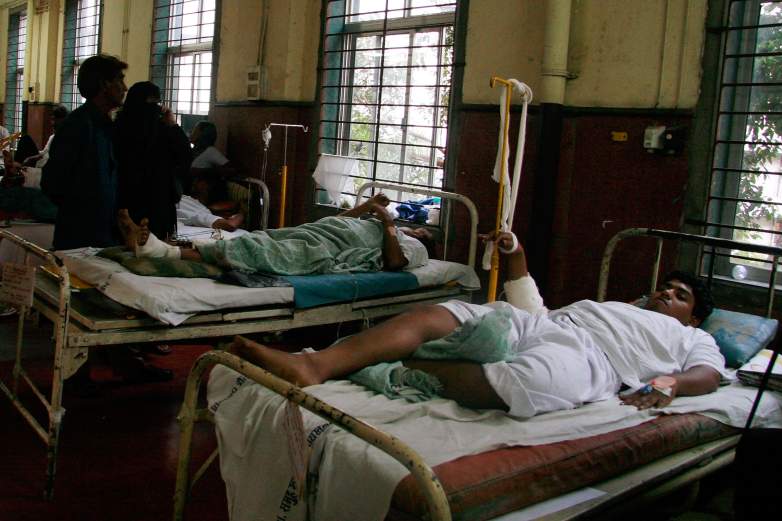
Casualties from the Chatrapati Shivaji Terminus (VT Station) receive treatment after being admitted to the JJ Hospital, November 29, 2008 in Mumbai, India.
Although a lot of the characters in the movie are fictionalized or compilations of real people, many harrowing true stories emerged in the aftermath of the attacks, and among them was heroism.
Bob Nicholls, a South African security consultant, was part of a group that barricaded itself inside a conference room, armed with meat cleavers. He survived. Nicholls and others slowly moved a group of 150 people out of the hotel. The scenes in the movie in which the head chef and other hotel staff barricade a large group of guests in a room before leading them to safety is reminiscent of Nicholls’ real-life actions as well as Oberoi’s.

GettyIndian commandos look down from a balcony of the Taj Mahal Palace & Tower Hotel after they gained control of it.
There were real stories of amazing survival. Chef Raghu Deora was lined up with a group of other guests and shot, but he survived.
There was a nanny who saved a baby in real life. Her name was Sandra Samuel, and she was an Indian nanny who saved the life of her charge, Moshe Holtzberg, 2. Both of the child’s parents died in the terror attacks. This is reminiscent of the wealthy couple featured in the movie; in the film, the mother, nanny, and baby live. However, the baby’s parents were killed at a Jewish center during the attacks in real life, not at the Taj.